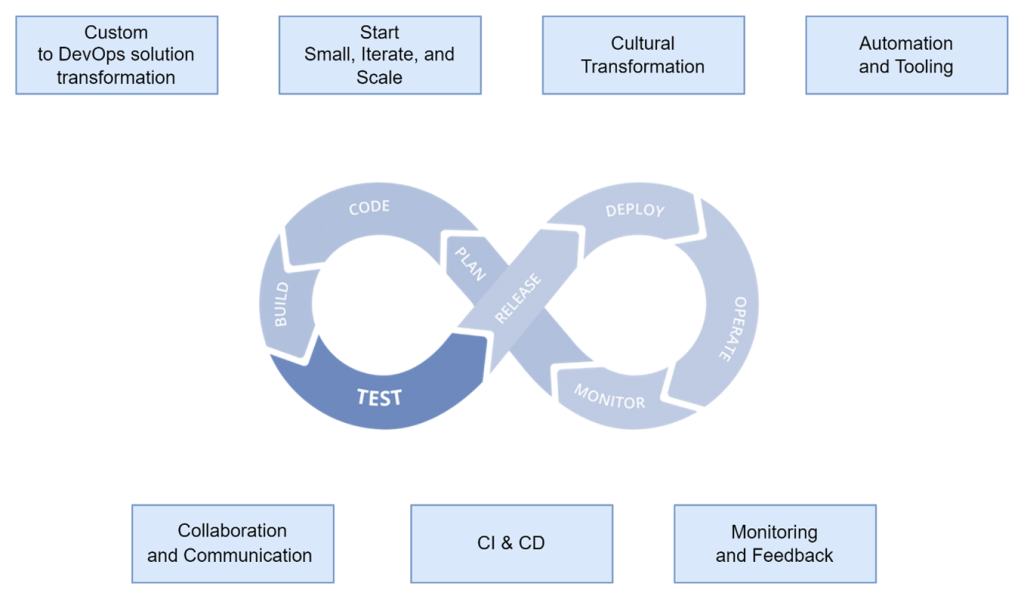In this blog, we will explore the scenario where we implemented the DevOps CI/CD generalized solution along with the challenges involved. Also, the strategies we followed for successful adoption.
Software engineering has several stages which include tasks such as code compilation, testing, deployment of software to various environments, and infrastructure provisioning. By automating these processes, DevOps reduces manual effort, minimizes errors, and speeds up software delivery. This automation not only improves efficiency but also ensures consistent and reliable software releases throughout the SDLC.
Challenges Overcame
The following pointers are the step-by-step guide to setting up a generalized DevOps CI/CD pipeline used by our team of experts in this scenario.

Custom to DevOps Solution Transformation
Obtaining leadership buy-in is a crucial part of successful DevOps adoption. Leaders need to understand the value proposition and be committed to providing the necessary resources and support. We took the implementation steps by delivering MVPs incrementally.
Start Small, Iterate, and Scale:
We identified a pilot project to implement the solution using industry-standard DevOps practices. This allowed us to experiment, fail fast, learn, and refine the processes before scaling across the organization. The iterative implementation enabled gradual improvement and reduced the risk of disruptive changes.
Cultural Transformation
Foster a culture of collaboration, transparency, and continuous learning. Educating application teams to embrace the DevOps process by providing adequate training and opportunities for skill development had helped in bridging the knowledge gap and achieving results.
Automation and Tooling
Choosing the right tools for a generalized DevOps CI/CD solution involved us identifying the right set of tools and technologies to support DevOps practices. We invested time in building infrastructure-as-code, configuration management with parameters, and deployment automation tools.
Collaboration and Communication
Established effective communication channels and collaboration platforms to facilitate smooth interaction between Development, Operations, and other teams. Foster a shared understanding of project goals, priorities, and timelines. Encourage regular meetings, stand-ups, and retrospectives to seek feedback and continuous improvement.
Continuous Integration and Delivery
Implemented continuous integration practices to ensure that code changes are regularly scanned for any code smells, integrated, built, and tested. Adopted continuous delivery to automate the deployment process and enable frequent and reliable releases helped the engineering teams to not worry about the build and deployment part of the SDLC process. This permitted the teams to quicker criticism, decreases the chance of integration issues, and guarantees a shorter time to market.
Monitoring and Feedback
We executed monitoring systems to pick up insights into application performance, infrastructure utilization, and client behaviors. Utilized the monitoring information to identify and resolve issues proactively, guaranteeing high system accessibility and reliability.
Benefits of Implementing a Generalized DevOps CI/CD Solution
DevOps offers various benefits to organizations to operate quicker, more proficiently, and provide high-quality software. By cultivating collaboration, automation, and continuous enhancement, DevOps empowers teams to work cohesively, eliminate silos, and adjust their efforts towards shared goals.
However, executing DevOps, organizations may confront challenges related to organizational culture, skill gaps, security, and tooling. In any case, they can be overcome by taking after the successful execution methodologies examined in this writeup.
DevOps is a progressing journey of continuous change, the service providers must know exactly how to optimize testing and quality assurance in a generalized DevOps CI/CD process. As well, organizations must regularly evaluate their processes, the viability of executed hones, and adapt to advancing requirements. By embracing DevOps standards, organizations can transform their software development and delivery capabilities, drive innovation, and stay competitive in today’s rapidly changing technology landscape.












